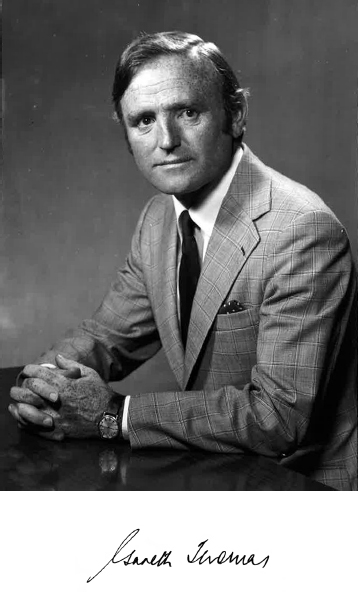1932–2014
Elected in 1982
“Pioneering work in the application of transmission-electron microscopy to materials science and engineering.”
BY RON GRONSKY
SUBMITTED BY THE NAE HOME SECRETARY
GARETH THOMAS, world leader in the application of electron microscopy to engineering materials analyses and longstanding distinguished member of the Berkeley faculty, died on February 6, 2014, in Oegstgeest, the Netherlands, at the age of 81.
Gareth was born in Maesteg, a small town in the south of Wales historically known for its iron and coal industries, on August 9, 1932. He spent his childhood attending primary and secondary schools in Maesteg while developing his athletic skills in both cricket and rugby. Ever the strong competitor, he sought and earned early admission to nearby Cardiff University, completing his bachelor of science degree in metallurgy with first class honors in 1952. He immediately began his graduate studies at the University of Cambridge, St. Catherine’s College, and, while still playing competitive rugby, completed all requirements for the PhD degree by 1956.
In 1958 Gareth married Elizabeth Cawdry and soon after moved to the United States, working briefly for a time in consulting roles for the aluminum industry, then, in 1960, accepting appointment as a visiting assistant professor of metallurgy at the University of California, Berkeley. As he would later tell his colleagues, “it was easy to plant roots in Berkeley.” He took a special liking to the Bay Area, immersing himself in
Berkeley’s community of scholars, strong rugby tradition, and culinary delights, finding special pleasure in short road trips to the nearby Napa Valley. Gareth and Elizabeth established their residence on Summit Road, at the top of the Berkeley hills, with a spectacular view of San Francisco Bay. True to form, he quickly joined the regular ranks of the professoriate the following year (1961), weathering the turmoil of the Free Speech Movement (1964) while launching his successful research portfolio and establishing more than enough momentum to attain the rank of full professor in 1966.
Professor Thomas’s research career began at Berkeley with a small electron microscopy lab in the basement of the Hearst Memorial Mining Building. Teaming with colleagues locally and from around the world, he worked diligently to establish the relationship between the internal structure of materials and their properties, bringing new understanding of engineering performance and how it might be optimized. He trained scores of graduate students and postdoctoral scholars in the nuances of electron microscopy, published a widely used textbook on the subject, and continued to grow his collection of electron microscopes beyond the confines of his campus space.
In 1976 Gareth and two colleagues, Robert Glaeser (Berkeley) and John Cowley (Arizona State University), proposed the creation of a National Center for Electron Microscopy to be housed on a new site at the Lawrence Berkeley National Laboratory. The idea eventually won favor with the Department of Energy, becoming a line item in the congressional budget of 1980. The NCEM was officially established in 1983, and Gareth served as its scientific director until 1991. His legacy is cemented at NCEM, along with over 500 technical publications and 10 patents, encompassing a lifetime of achievement in the development of engineering materials.
His tireless work ethic also earned him a multitude of awards, from the Institute of Metals (London) National Undergraduate Student Prize in 1953, to ASM International’s Gold Medal in 2001, with numerous honorary memberships and degrees from a host of international institutions in the intervening years, including memberships in both the NAE (1982)
and NAS (1983). Gareth’s talents in leadership were also recognized by his appointments and elections to the presidency of the Electron Microscopy Society of America (1975) and the International Federation of Societies for Electron Microscopy (1986). He gave freely of his time in service to the profession on the TMS-AIME Board of Directors (1978), as chairman of the Acta Metallurgica board of governors (1982), on the National Research Council, and as editor in chief of Acta Materialia and Scripta Materialia. He also served a year at the helm of the Technology Transfer Centre at the Hong Kong University of Science & Technology, Kowloon (1993) and as chief technology officer of the specialty alloy company MMFX® Steels, which licensed one of Gareth’s patents for high-strength corrosion-resistant ferrous steels.
Former students and colleagues also recall Gareth’s zest for life outside of the lab. He enjoyed a succession of sports cars, skiing, opera, an exquisitely well-appointed wine cellar (enabling many memorable wine tastings for his research group), sports (the San Francisco Giants, San Francisco 49ers, and, of course, the Rugby World Cup), and travel, the last of these inducing his graduate students to calculate his “mean elevation above sea level” during an especially busy semester! He is still missed and recalled fondly during all of the annual electron microscopy society meetings around the world.
Above all, Gareth wanted to be remembered as a loving husband, father, and grandfather. His first wife Elizabeth died in 2007. He is survived by his wife Annelies, son Julian, daughter-in-law Kimberly, and two grandchildren.





